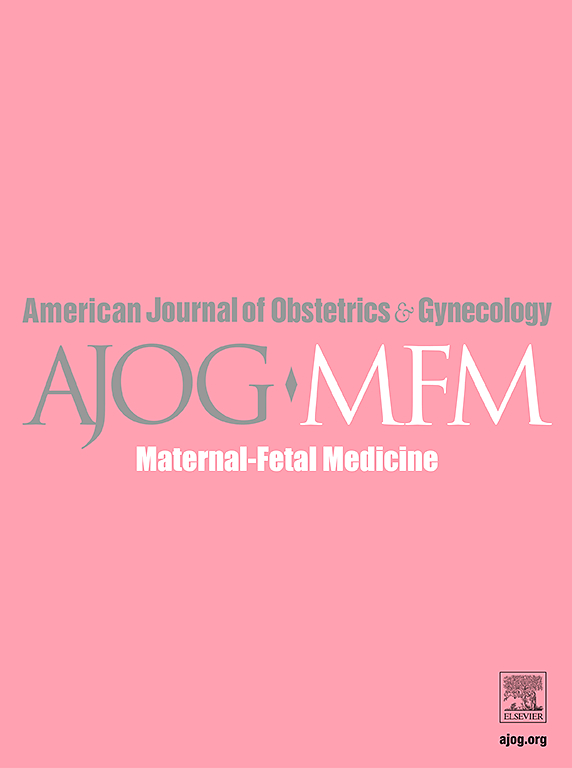Effectiveness of a cervical pessary in prolongation of pregnancy after an arrested episode of preterm labor: a systematic review and individual patient data meta-analysis
IF 3.1
2区 医学
Q1 OBSTETRICS & GYNECOLOGY
American Journal of Obstetrics & Gynecology Mfm
Pub Date : 2025-05-05
DOI:10.1016/j.ajogmf.2025.101690
引用次数: 0
Abstract
Background
Randomized controlled Trials (RCTs) show conflicting results on the effectiveness of a cervical pessary after an arrested episode of preterm labor (PTL) aiming to prolong pregnancy.
Objective
To assess the effectiveness of a cervical pessary in prolongation of pregnancy after an arrested episode of PTL by utilizing individual participant data (IPD) meta-analysis.
Data sources
Databases Central, Embase, Medline, and clinical trial databases (ClinicalTrials.gov, ISRCTN, EU-CTR) were searched from inception until January 2024.
Study Eligibility Criteria
Randomized controlled trials investigating individuals between 24+0 and 34+0 weeks of gestation with an arrested episode of PTL and who were subsequently randomized to cervical pessary or no intervention.
Study Appraisal and Synthesis Methods
Studies were assessed for data integrity and risk of bias. Main outcomes were prolongation of pregnancy >7 days, interval between randomization and delivery, and a composite of adverse neonatal outcome. A one-step meta-analysis approach was employed, and the intention-to-treat principle was applied.
Results
Four RCTs had IPD available. In singleton pregnancies (total N=546; 275 individuals in the pessary group, 271 individuals in the control group), pessary placement did not decrease delivery risk within 7 days (relative risks [RR] 0.87; 95% confidence intervals [CI] 0.40–1.9), prolong pregnancy (mean differences 4.5 days; 95% CI –0.08 to 9.0), nor reduce the risk of adverse neonatal outcomes (RR 0.95; 95% CI 0.53–1.7). The incidence of readmissions for a new episode of PTL was significantly less frequent in the cervical pessary group (RR 0.66, 95% CI 0.50–0.85). Two studies investigating multiple pregnancies (N=167, 84 individuals in the pessary group, 83 individuals in the control group) were identified, showing contradictory results that could not be explained by study differences. Therefore, merging IPD and pooling of was uninformative.
Conclusion
In individuals with a singleton pregnancy with an episode of PTL between 24 and 34 weeks of gestational age, pessary placement does not prevent delivery within 7 days, preterm birth, or neonatal outcomes. A pessary might reduce the probability of readmissions for PTL.
宫颈托在早产停搏后延长妊娠的有效性:系统回顾和个体患者数据荟萃分析。
背景:随机临床试验(RCTs)显示,在早产(PTL)停止发作后使用宫颈托器以延长妊娠的有效性存在矛盾的结果。目的:通过个体参与者数据(IPD)荟萃分析,评估宫颈托在早产(PTL)骤停发作后延长妊娠的有效性。数据来源:数据库中心,Embase, Medline和临床试验数据库(ClinicalTrials.gov, ISRCTN, EU-CTR)从成立到2024年1月进行检索。研究资格标准:随机对照试验调查妊娠24+0至34+0周之间有PTL骤停发作的个体,随后随机分配到宫颈托或不干预组。研究评价和综合方法:评估研究的数据完整性和偏倚风险。主要结局是妊娠期延长(7天)、随机分组和分娩间隔以及新生儿不良结局的综合。采用一步荟萃分析方法,采用意向治疗原则。结果:4个随机对照试验有IPD。单胎妊娠(总N=546;子宫托组275人,对照组271人),子宫托放置没有降低7天内分娩风险(RR 0.87;95% CI 0.40 ~ 1.9),延长妊娠期(MD 4.5天;95% CI -0.08 ~ 9.0),并不能降低新生儿不良结局的风险(RR 0.95;95% CI 0.53 ~ 1.7)。宫颈托组PTL新发作再入院的发生率明显较低(RR 0.66, 95% CI 0.50 ~ 0.85)。两项调查多胎妊娠的研究(N=167,子宫托组84例,对照组83例)显示了相互矛盾的结果,不能用研究差异来解释。因此,合并个体参与者数据和池化是没有信息的。结论:在24 - 34周孕龄的单胎妊娠伴PTL发作的个体中,子宫托放置不能预防7天内分娩、早产或新生儿结局。托钵可以减少PTL再入院的可能性。
本文章由计算机程序翻译,如有差异,请以英文原文为准。
求助全文
约1分钟内获得全文
求助全文
来源期刊

American Journal of Obstetrics & Gynecology Mfm
Medicine-Medicine (all)
CiteScore
7.40
自引率
3.20%
发文量
254
审稿时长
40 days
期刊介绍:
The American Journal of Obstetrics and Gynecology (AJOG) is a highly esteemed publication with two companion titles. One of these is the American Journal of Obstetrics and Gynecology Maternal-Fetal Medicine (AJOG MFM), which is dedicated to the latest research in the field of maternal-fetal medicine, specifically concerning high-risk pregnancies. The journal encompasses a wide range of topics, including:
Maternal Complications: It addresses significant studies that have the potential to change clinical practice regarding complications faced by pregnant women.
Fetal Complications: The journal covers prenatal diagnosis, ultrasound, and genetic issues related to the fetus, providing insights into the management and care of fetal health.
Prenatal Care: It discusses the best practices in prenatal care to ensure the health and well-being of both the mother and the unborn child.
Intrapartum Care: It provides guidance on the care provided during the childbirth process, which is critical for the safety of both mother and baby.
Postpartum Issues: The journal also tackles issues that arise after childbirth, focusing on the postpartum period and its implications for maternal health. AJOG MFM serves as a reliable forum for peer-reviewed research, with a preference for randomized trials and meta-analyses. The goal is to equip researchers and clinicians with the most current information and evidence-based strategies to effectively manage high-risk pregnancies and to provide the best possible care for mothers and their unborn children.
 求助内容:
求助内容: 应助结果提醒方式:
应助结果提醒方式:


